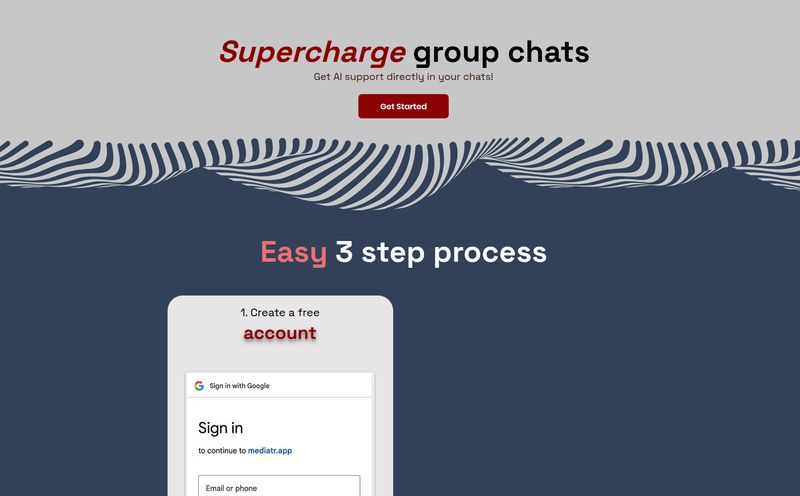If you've ever tried to learn a new language, you know the drill. You download Duolingo, you blaze through the first few levels, feeling like a genius because you can say "the boy eats an apple." You might even buy a grammar book. But then... you hit the wall. That dreaded intermediate plateau where you know a bunch of words but can’t actually speak. You can read a menu, maybe, but ordering from it? Terrifying.
For years, the solution has been to either move abroad or shell out for a private tutor on a platform like iTalki. Both are great options, but one requires a passport and a lot of courage, and the other requires a pretty healthy budget. I've spent more than I'd like to admit on conversational practice. So when I see a new tool pop up that promises to bridge this gap, my ears perk up. The latest one on my radar is Langchats, which calls itself an "AI language partner."
The promise is huge: get the conversational practice you desperately need, anytime, anywhere, without the cost or pressure of a human tutor. But in this age of AI-everything, you have to wonder... is it just another gimmick, or is this the real deal? I decided to take a look.
Beyond the Flashcards: What Exactly is Langchats?
So, what is Langchats? At its core, it’s a platform designed to get you from knowing a language to using it. Instead of endless matching games or fill-in-the-blanks, its entire model is built around conversation. Think of it like ChatGPT, but specifically trained to be your language sparring partner. You don't just learn vocabulary; you engage in natural-sounding dialogue to build real conversational fluency.
The whole idea is to simulate real-world chats. We all know that feeling of our brains freezing when a native speaker asks us a question. The goal here is to get your reps in, to make those connections in your brain fire faster, so you’re not just translating in your head. It’s about building instinct. This is something I’ve always felt is the missing piece in most language apps.
A Look Under the Hood: The Key Features
A tool is only as good as its features, right? Langchats has a pretty focused set of tools aimed squarely at improving your speaking skills. It’s not trying to be everything to everyone, which I actually appreciate.
AI-Powered Conversations: The Heart of the Platform
This is the main event. You chat with the AI, either by typing or, more importantly, by using your voice. The AI responds in kind, creating a back-and-forth exchange. This is where the magic is supposed to happen. It's not a scripted bot that can only say five things. It's dynamic. You drive the conversation, and it adapts. It’s your ever-patient partner who doesn't mind if you take 30 seconds to remember the word for “library.”
Context is King: Setting Your Own Scenes
I love this part. The platform lets you provide the context for the conversation. You're not stuck with generic topics like "the weather." You can literally tell it, "Let's pretend I'm at a coffee shop in Paris and I want to order a croissant and ask for directions to the Louvre." This is insanely practical. You can practice the exact scenarios you’ll face in real life. Planning a trip to Tokyo? You can spend a week practicing how to check into a hotel, order ramen, and ask for help at the train station. It makes the learning immediately applicable.
Instant Feedback (Without the Judgement)
Here's a big one for me, and probably for you too. Talking to a human tutor is great, but there's always a little bit of performance anxiety. You don't want to sound stupid. The AI provides a no-judgment zone. If you make a mistake, it gives you instant feedback and corrections. It’ll point out grammatical errors or suggest a more natural way to phrase something. This is crucial. It’s what linguist Stephen Krashen called lowering the "affective filter." When you're not stressed, you're more open to learning. Simple as that.

Visit Langchats
More Than Just "Hola": Supporting 30+ Languages
The platform supports over 30 languages, which is impressive. It’s got the big ones like Spanish, French, German, and Italian, but also languages that are often harder to find resources for. This wide range means it’s not just for those learning a romance language. Whatever your target language is, there's a good chance Langchats has you covered.
Voice, Translations, and Suggestions
To round things out, it has all the little support tools you’d hope for. You can use your voice, which is a must for speaking practice. If you get stuck, you can get a quick translation of a word or phrase. And my personal favorite, the "suggestions" feature. If you’re drawing a complete blank on how to respond, it will give you a little nudge in the right direction. It’s like a safety net that keeps the conversation from grinding to a halt.
So, is it Any Good? The Honest Pros and Cons
No tool is perfect. Let’s break down the good, the bad, and the AI. After playing around with it, I've got some thoughts.
On the plus side, it’s incredibly flexible and affordable. The ability to practice speaking at 2 AM in your pajamas is a game-changer. You're not bound by anyone else's schedule. And compared to the $20-$40+ an hour you might pay for a human tutor, an AI-based subscription is almost certainly going to be a fraction of the cost. The instant feedback is another massive win. You don’t have to wait for your next lesson to find out you’ve been saying something wrong for a week.
However, we need to be realistic. This is not a human. It won't pick up on the subtle cultural nuances, the body language, or the shared laughter that comes with talking to a real person. Its effectiveness is also tied directly to the quality of the AI model. While AI is getting scarily good, it can still sometimes miss context or sound a bit... well, robotic. And a big one for me: the mobile app is still listed as "coming soon." In 2024, not having a dedicated app feels like a bit of a miss, as most of my language learning happens on the go.
Let's Talk Money: Langchats Pricing
This is where things get a little fuzzy. The website prominently features a "Start Learning Free" button, which is great. It suggests there's a free trial or a freemium model to let you test the waters before committing. Honestly, any company confident in its product should do this.
That said, I couldn't find a clear, dedicated pricing page with neat little boxes showing different tiers. This lack of transparency is a small pet peeve of mine. I'd assume they have a subscription model—monthly, yearly, whatever—that you discover after signing up. I'm hoping for something reasonable, in the ballpark of other AI learning tools. For now, the best bet is to sign up for the free start and see what the upgrade options look like from the inside.
Is Langchats Right for Your Language Goals?
So, who should jump on this? In my opinion, Langchats is perfect for the upper-beginner to intermediate learner. You've got the basic grammar and vocabulary down, but you need to build speed, confidence, and conversational flow. It's for the person who feels stuck and needs a ton of practice without breaking the bank.
Who should maybe wait? If you are an absolute, day-one beginner, you might still need a more structured course that teaches you the absolute fundamentals first. Langchats seems geared towards practice, not initial instruction. Also, if you’re an advanced learner looking for deep, philosophical discussions or nuanced debate practice, the AI might not (yet) have the sophistication you crave. For that, a human partner is probably still your best bet.
Your Questions Answered: Langchats FAQ
How does the AI conversation actually work?
You provide a topic or scenario, and the AI, powered by a model similar to ChatGPT, generates responses to create a natural conversation. You can speak or type, and it will correct your grammar and suggest better ways to say things.
What languages does Langchats support?
It supports over 30 languages. This includes widely spoken ones like Spanish, French, and German, as well as many others, offering a broad range for learners.
Is there a free trial available?
Yes, the website advertises a "Start Learning Free" option, allowing you to try the platform's features before you have to pay for anything.
Can I use it on my phone?
Not with a dedicated app, at least not yet. The website states that a mobile app is "coming soon." You can likely use it through your phone's web browser, but the experience might be better on a desktop.
How does it track my progress?
The platform includes progress tracking and analytics. It monitors your conversations, learning streaks, and vocabulary usage to give you a dashboard view of how you're improving over time.
Is it better than a human tutor?
It's different. It's more affordable, available 24/7, and offers a pressure-free environment. A human tutor provides cultural insight, real-world nuance, and genuine connection. They serve different but complementary purposes.
Final Thoughts: A New Tool in the Toolbox?
So, what’s the verdict? I’m cautiously optimistic. Langchats isn't trying to replace human teachers, and it shouldn't. What it is trying to do is solve a very real, very frustrating problem for millions of language learners: the lack of accessible, low-stakes speaking practice.
It’s like having a gym membership for your language skills. You still need a coach (a teacher or a structured course) to teach you proper form, but Langchats is where you go to build the muscle, day in and day out. It’s a powerful supplement, a tool that could genuinely help a lot of people break through that dreaded plateau and finally start having the conversations they’ve been dreaming of. And for that reason alone, it’s definitely worth a look.
Reference and Sources
- Langchats Official Website
- Krashen, S. D. (1982). Principles and Practice in Second Language Acquisition. Pergamon Press. (Regarding the Affective Filter Hypothesis)



